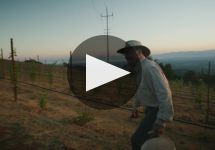Ridge Geyserville 2022
-
Wine
Spectator -
James
Suckling -
Robert
Parker - Vinous
- Decanter
-
Wilfred
Wong -
Wine
Enthusiast
Most Gifted



Product Details
Your Rating
Somm Note
Winemaker Notes
Deep ruby in color with aromas of black cherry, dark plum, sarsaparilla, baking spices, toasted oak, and lavender. A fresh entry with bold red cherry and raspberry flavors. Subtle tannins and natural acidity lead to a long and pleasant finish.
Blend: 67% Zinfandel, 20% Carignane, 10% Petite Sirah, 3% Mataro
Professional Ratings
-
Wine Spectator
Deeply structured and bright with acidity, this combines power with grace. Black cherry and dark plum flavors take on licorice, green peppercorn and Asian five-spice accents as this builds toward broad-shouldered tannins.
-
James Suckling
This zinfandel-dominant field blend is ripe, delicious and lush, with light, spicy oak accents over plump blackberries, blueberries and vanilla bean. Saturated and opulent but not fat, as moderate tannins and some raspberry-like acidity balance the full body. 67% zinfandel, 20% carignan, 10% petite sirah and 3% mataro.
-
Robert Parker's Wine Advocate
The 2022 Geyserville is a blend of 67% Zinfandel, 20% Carignane, 10% Petite Sirah and 3% Mataro. It has kaleidoscopic aromas of boysenberry jam, grilled beef, dried lavender, iron, violet and peach. The medium-bodied palate features generous, floral flavors.
-
Vinous
A blend of 67% Zinfandel, 20% Carignane, 10% Petite Sirah and 3% Mourvèdre, the 2022 Geyserville is packed to the gills with purple fruit and a ridiculous amount of spice—exotic spice, brown spice, baking spice, you name it. Blueberry, black plum, new leather, menthol and tobacco explode from the glass, all wrapped up in forceful, imposing tannins. A kick of mocha/espresso-scented toasty oak rounds out the finish. This is a take-no-prisoners rendition of Geyserville that will definitely benefit from some sideways time in the cellar.
-
Decanter
Ridge has been making the Geyserville since 1966, a true Zinfandel icon with a readiness to drink now and classic Ridge ageability. This wine is made as a field blend, spending 16 months in American oak, and only 28% is new. Rich fruit aromas, with pungent spices, ripe red and black plums, Christmas spices and notes of smoked cinnamon. The palate offers a fresh acidity which buoys the ripe blackberries and spicy black plums. There's plenty of structure for this wine to go the distance, typical of the house style (at least a decade).
-
Wilfred Wong of Wine.com
MY PUBLISHED NOTES: COMMENTARY: The 2022 Ridge Geyserville shows excellent power and richness in its aromas and flavors TASTING NOTES: This wine offers a lovely balance of blackberries and spices in its aromas and flavors. Pair with grilled lamb kebabs. (Tasted: April 14, 2024, San Francisco, CA)
-
Wine Enthusiast
Dark and intense on the nose, this wine displays aromas of crushed black cherry, black plum and crème de cassis. The palate brings flavors of macerated cherries and blackberries, spiced fig compote, cedar and a decadent plush texture. Precision-balanced acidity runs through the finish.
Other Vintages
2023-
Jeb
Dunnuck -
Wine
Spectator
-
Wilfred
Wong -
Wine &
Spirits -
Wine
Enthusiast -
Wine
Spectator -
Jeb
Dunnuck
-
Wilfred
Wong - Decanter
-
Tasting
Panel -
Wine &
Spirits -
Wine
Spectator - Vinous
-
Tasting
Panel -
James
Suckling - Vinous
-
Wine &
Spirits -
Wilfred
Wong -
Wine
Spectator
-
Robert
Parker -
Jeb
Dunnuck -
Wine &
Spirits -
Wine
Spectator -
Connoisseurs'
Guide
-
Robert
Parker -
Wilfred
Wong -
James
Suckling -
Connoisseurs'
Guide -
Jeb
Dunnuck
-
James
Suckling -
Jeb
Dunnuck -
Robert
Parker
-
Connoisseurs'
Guide -
Wilfred
Wong -
Wine
Spectator
-
Robert
Parker -
Wilfred
Wong
-
Robert
Parker
-
Robert
Parker - Decanter
-
Wine
Enthusiast
-
Robert
Parker
-
Connoisseurs'
Guide -
Jeb
Dunnuck -
Robert
Parker
-
Connoisseurs'
Guide -
Wine
Spectator -
Robert
Parker
-
Wine &
Spirits -
Wine
Spectator -
Connoisseurs'
Guide
-
Connoisseurs'
Guide -
Jeb
Dunnuck
-
Connoisseurs'
Guide
-
Connoisseurs'
Guide
-
Robert
Parker
-
Wine
Spectator -
Robert
Parker
-
Robert
Parker -
Jeb
Dunnuck
-
Wine
Spectator
-
Robert
Parker -
Wine
Spectator
-
Robert
Parker

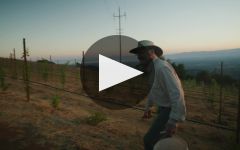
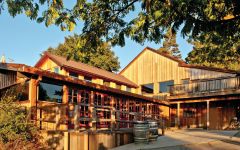

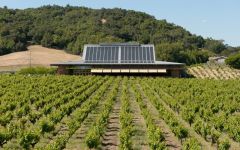
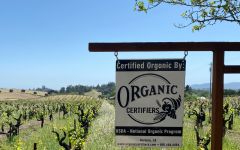
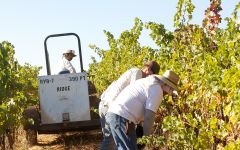
RIDGE's history begins in 1885, when Osea Perrone, a doctor and prominent member of San Francisco's Italian community, bought 180 acres near the top of Monte Bello Ridge in the Santa Cruz Mountains. He planted vineyards and constructed a winery of redwood and native limestone in time to produce the first vintage of Monte Bello in 1892. The historic building now serves as the RIDGE production facility.
In 1962, Ridge Vineyards made its first Monte Bello, and two years later its first zinfandel. The RIDGE approach is straightforward: find the most intense and flavorful grapes, guide the natural process, draw all the fruit's richness into the wine. Decisions on when to pick, when to press, when to rack, what varietals and what parcels to include and when to bottle, are based on taste. To retain the nuances that increase complexity, Ridge winemakers handle the grapes and wine as gently as possible. There are no recipes, only attention and sensitivity.
In August 2021, Ridge Vineyards joined International Wineries for Climate Action (IWCA), a group of like-minded wineries that are dedicated to decarbonizing the global wine industry. RIDGE is committed to achieving Net Zero by 2050 and completes a biannual greenhouse gas audit utilizing the World Resources Institute Greenhouse Gas (GHG) Protocol methodology and be verified by an internationally accredited, third-party auditor.

With hundreds of red grape varieties to choose from, winemakers have the freedom to create a virtually endless assortment of blended red wines. In many European regions, strict laws are in place determining the set of varieties that may be used, but in the New World, experimentation is permitted and encouraged resulting in a wide variety of red wine styles. Blending can be utilized to enhance balance or create complexity, lending different layers of flavors and aromas. For example, a red wine blend variety that creates a fruity and full-bodied wine would do well combined with one that is naturally high in acidity and tannins. Sometimes small amounts of a particular variety are added to boost color or aromatics. Blending can take place before or after fermentation, with the latter, more popular option giving more control to the winemaker over the final qualities of the wine.
How to Serve Red Wine
A common piece of advice is to serve red wine at “room temperature,” but this suggestion is imprecise. After all, room temperature in January is likely to be quite different than in August, even considering the possible effect of central heating and air conditioning systems. The proper temperature to aim for is 55° F to 60° F for lighter-bodied reds and 60° F to 65° F for fuller-bodied wines.
How Long Does Red Wine Last?
Once opened and re-corked, a bottle stored in a cool, dark environment (like your fridge) will stay fresh and nicely drinkable for a day or two. There are products available that can extend that period by a couple of days. As for unopened bottles, optimal storage means keeping them on their sides in a moderately humid environment at about 57° F. Red wines stored in this manner will stay good – and possibly improve – for anywhere from one year to multiple decades. Assessing how long to hold on to a bottle is a complicated science. If you are planning long-term storage of your reds, seek the advice of a wine professional.

Nearly a northern extension of Napa Valley, Alexander Valley starts just north of the small, Knights Valley, and is just a few minutes drive from the Napa town of Calistoga. It is Sonoma County’s hottest AVA. But the Russian River, which runs through the valley, creates cooler pockets and its soft, alluvial soil is ideal for grape growing, especially Cabernet Sauvignon. In fact, some believe that Alexander Valley Cabernets truly rival the best from Napa Valley and many of the heavy-hitter producers have largely invested here.
In addition to Cabernet Sauvignon, which makes up over 50% of plantings, Merlot and old vine Zinfandel thrive here. Ample, fleshy Chardonnay and Sauvignon Blanc dominate white wine production. Some old-vine plantings of Grenache have also been discovered and more recent experiments with Sangiovese and Barbera show great promise.
